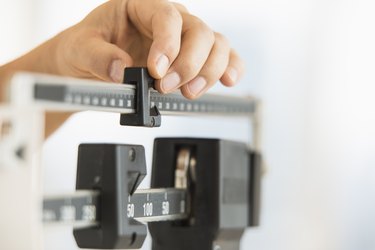
If you've ever tried to change your physique, you've probably heard (or, more likely, read on the internet) that muscle weighs more than fat. It's something a lot of us have accepted as fact, but is it actually true? And does muscle really burn more calories than flab?
Here, we explain the weight of the matter (pun intended!), including what muscle and fat do to your metabolism and physique, and how to easily swap extra inches for leanness.
Video of the Day
Video of the Day
Fat vs. Muscle: The Basics
Comparing fat to muscle is like comparing apples to oranges. Yes, both are metabolically active and necessary in your body, but too much of one can be detrimental to your health while the other is very beneficial.
Body Fat 101
The fat contained in your fat cells exists in a form of triglycerides, which act as fuel. Body fat can be stored in different ways. One is subcutaneously, or just underneath the skin (the soft kind you can pinch), and according to Harvard Health Publishing, this type makes up 90 percent of your body fat. Subcutaneous fat acts as insulation and a source of energy. It also produces beneficial molecules that help regulate hunger and your weight. But you know what they say about too much of a good thing…
In most cases, if you have a lot of soft fat and have overweight, then you probably have a lot of visceral fat — the hard kind that's deep down in your abdomen, wrapped around your organs and the more dangerous of the two. It produces a higher number of molecules linked with possible detrimental health effects like insulin resistance, high blood pressure and high cholesterol as well as heart disease, type 2 diabetes and certain cancers.
Read more: The 6 Big Health Risks of Too Much Belly Fat
Muscle 101
Then we have skeletal muscle, the type of muscle around your bones that provides strength and stabilization. It's the largest tissue in the body, constituting up to 40 percent of your body weight, per researchers at the University of New Mexico.
Like fat, it's influenced by genetics, hormones, physical activity and diet. It also contains 50 to 75 percent of all proteins in your body, making it the main tissue that metabolizes amino acids, which is linked to muscle development and growth — and muscle development and growth are linked to a higher metabolic rate (yay for calorie burning!). But more on that in a minute.

A Pound Is a Pound...
There's that common myth: A pound of muscle weighs more than a pound of fat. But a pound is a pound — whether you're talking about 16 ounces of bricks, pennies or feathers, they all weigh the same. What's interesting is that while this holds true, muscle does take up less space than fat.
"People say this a lot, probably because you can have more muscle and actually appear smaller than someone who weighs the same and has more fat on their body," says Amanda Mancini, a National Academy of Sports Medicine (NASM)-certified fitness trainer, weight-loss specialist and corrective exercise specialist.
Wondering if your body fat percentage is in a healthy range? Use the LIVESTRONG.com Body Fat Calculator to easily find out.
...but It's a Matter of Space
Sometimes the number on the scale isn't the best gauge of your size or even your underlying health risks. Here's why: Muscle is denser than fat, according to The Social & Health Research Center, which means it takes up less space (think about the difference between a pound of rocks vs. a pound of puffy marshmallows). In fact, muscle actually takes up around four-fifths as much space as fat.
OK, so the difference probably isn't as big as you thought, but even so, two people may be the same height and weight, but the person with a higher percentage of body fat will wear a bigger clothing size and may have more inches to pinch compared to the smaller, tighter body of someone with more lean muscle, says Mancini. Muscle: 1, fat: 0.
But truth be told, since it is denser, muscle does actually weigh a tad bit more than fat in volume. On average, the density of fat is 0.9 g/mL, while the density of muscle is 1.1 g/mL.

Muscle vs. Fat and Your Metabolism
Basal metabolic rate (BMR), per the American Council on Exercise, represents the minimum amount of energy (calories) needed to keep your body functioning. In other words, it's an approximation of the number of calories you'd burn if you were to do nothing but rest for 24 hours. BMR makes up 60 to 75 percent of the total calories used each day.
Common gym lore says that 1 pound of resting muscle will burn 30 to 50 calories daily compared to fat, which burns no calories. The truth, according to the National Council on Strength and Fitness, is that muscle tissue — at rest — will burn approximately 6 calories daily per pound, while fat burns 2 to 3 calories daily per pound. Muscle: 2, fat: 0.
Read more: Your Ultimate Guide to Gaining Lean Muscle
What's also important to remember is that strengthening the muscle you already have is just as important as building new muscle. The bad news, according to the ACE, is that the amount of muscle mass you have declines as you age, especially if you don't strength train, so you'll end up with a fattier body composition.
But there's good news: If you stick to a regular strength-training regimen, you might expect to gain approximately 2 to 4.5 pounds of muscle mass over the course of several months and to boost your resting metabolism by up to about 30 calories per day. Muscle: 3… OK, you get the point.
Of course, this depends on body composition, diet and frequency of training. "It's very hard to actually measure this for the average person unless he was going to get a body fat measurement," says Mancini. Regardless, the best way to benefit from the calorie-burning potential of your muscles is to actually use them.

Build Muscle, Lose Fat
Though swapping fat for muscle might not raise your basal metabolic rate as you much as you were hoping, it's still a good idea to pick up those weights. A study published in April 2014 in the Journal of Sports Sciences that included 139 teens with obesity concluded that cardio plus resistance training had better results with regard to decreased body fat mass (both soft fat and hard belly fat) and increased body lean mass.
And remember — high body fat percentages are associated with an elevated risk for obesity-related diseases such as type 2 diabetes, heart disease, high blood pressure, breathing problems, gallstones and cancer. But a review published in March 2012 in Obesity Reviews found that resistance training changes body fat distribution and may be a major help in reducing abdominal obesity and metabolic disease.
So, how often should you work your muscles? The Physical Activity Guidelines for Americans recommend training your major muscle groups at least twice a week to reap the healthy benefits. And indeed, a review published November 2016 in Sports Medicine found that this frequency was effective for building lean muscle mass.
If you're new to strength training, the Mayo Clinic suggests starting off with one to two sets of 12 to 15 reps for all major muscle groups with weights that tire your muscles by the end of the reps. Just be patient, keep at it and you'll eventually be able to increase the weight or resistance.
- Harvard Health Publishing: "Taking Aim at Belly Fat"
- University of New Mexico: "Controversies in Metabolism"
- The Social & Heath Research Center: "Fat versus Muscle??"
- American Council on Exercise: "Trimming Off the Fat"
- American Council on Exercise: "Is it True that Metabolism Decreases with Age?"
- Journal of Sports Sciences: "Aerobic Plus Resistance Training was More Effective in Improving the Visceral Adiposity, Metabolic Profile and Inflammatory Markers than Aerobic Training in Obese Adolescents"
- Obesity Reviews: "Resistance Training, Visceral Obesity and Inflammatory Response: A Review of the Evidence"
- Sports Medicine: "Effects of Resistance Training Frequency on Measures of Muscle Hypertrophy: A Systematic Review and Meta-Analysis"
- Mayo Clinic: "Strength Training: Get Stronger, Leaner, Healthier"
- U.S. Department of Health and Human Services: "Physical Activity Guidelines for Americans"
- Yale Scientific: "Targeted Fat Loss: Myth or Reality?"
- “Exercise Physiology”; William D. McArdle, et al.; 2009
- OpenStax: "Skeletal Muscle"
- Baylor College of Medicine: "Muscle Doesn't Weigh More Than Fat"
- Banister Nutrition: "Fat vs. Muscle"